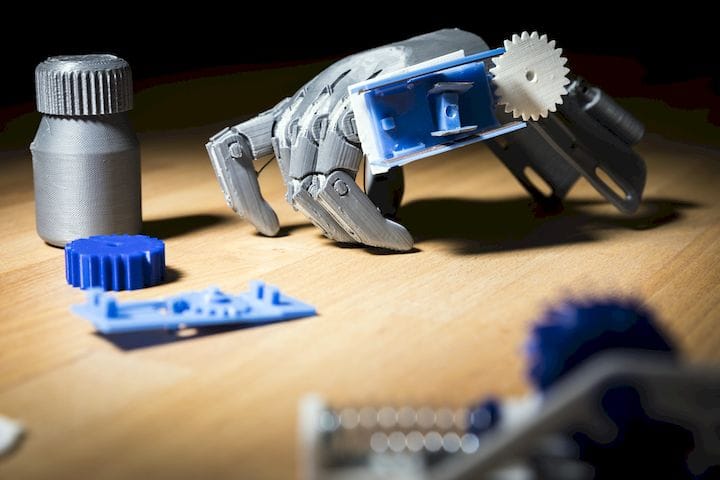![3D printed mechanical objects that can be electronically monitored [Source: University of Washington]](https://fabbaloo.com/wp-content/uploads/2020/05/image-asset_img_5eb0a47596fc9.jpg)
Researchers have found a way to monitor mechanical usage of a 3D printed object without requiring any electronics in the object.
The researchers at the University of Washington have been developing many startling innovations in the 3D printing field, and this latest development seems to have been built on their previous work, in which they were able to 3D print objects that could communicate electronically via WiFi without any onboard electronics.
Their approach was (and is) quite interesting: they mixed in a small amount of fine copper powder into their 3D print material. Then the printed object was subjected to a WiFi network. This network simply splashes electronic waves on the object, just as it would an electronic device. Normally, an electronic device would “hear” the waves and react accordingly.
But there is no electronic module in the print; instead the signals bounce off any electronically reflective material they encounter, like, say, that copper powder.
![Research team at the University of Washington developing remotely monitorable 3D prints [Source: University of Washington]](https://fabbaloo.com/wp-content/uploads/2020/05/image-asset_img_5eb0a4763151d.jpg)
By engineering the design of the copper application they were able to actually detect a change of position of the object, thus commencing communication. In their earlier example, they constructed a pushbutton switch that could be detected.
Now they seem to have taken the concept much further. Professor Jennifer Mankoff, co-author of the research, says:
“We’re interested in making accessible assistive technology with 3D printing, but we have no easy way to know how people are using it. Could we come up with a circuitless solution that could be printed on consumer-grade, off-the-shelf printers and allow the device itself to collect information? That’s what we showed was possible in this paper.”
Lead author Vikram Iyer explains:
“Last time, we had a gear that turned in one direction. As liquid flowed through the gear, it would push a switch down to contact the antenna. This time we have two antennas, one on top and one on bottom, that can be contacted by a switch attached to a gear. So opening a pill bottle cap moves the gear in one direction, which pushes the switch to contact one of the two antennas. And then closing the pill bottle cap turns the gear in the opposite direction, and the switch hits the other antenna.”
Co-author Justin Chan describes the technology:
“The gear’s teeth have a specific sequencing that encodes a message. It’s like Morse code. So when you turn the cap in one direction, you see the message going forward. But when you turn the cap in the other direction, you get a reverse message.”
![3D printed gears that are encoded to report motion [Source: University of Washington]](https://fabbaloo.com/wp-content/uploads/2020/05/image-asset_img_5eb0a4767f5d6.jpg)
This is an incredible development. It could enable the easy production of all manner of monitorable devices, and even those that directly communicate with a host through the switch technology mentioned above. It’s like making smart objects without electronics. These devices would literally never require batteries or wear out their “pseudo-electronic” capabilities.
However, such a configuration would require a WiFi source network and complex listening software.
I’m wondering how this could play out: Would there need to be a set of communication standards for this to take place, enabling easy setup and avoiding network collisions? Would specialized frequencies be allocated for this process?
I’m not sure, but this is such a new concept that I’m certain no one knows what might yet be possible.











A research thesis details the incredibly complex world of volumetric 3D printing. We review the highlights.